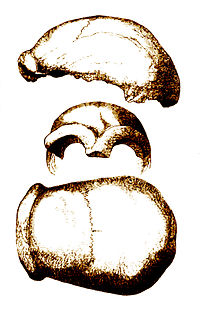- Neanderthal 1
-
Feldhofer 1, Neanderthal 1 is the common name for the initial 40,000-year-old Neanderthal specimen found in Kleine Feldhofer Grotte in August 1856. It represents the beginning of paleoanthropology as a scientific discipline.
The discovery was made in Feldhofer grotto in a limestone quarry located in Neanderthal, Germany. Neanderthal 1 consisted of a skull cap, two femora, the three right arm bones, two of the left arm bones, ilium, and fragments of a scapula and ribs. The fossils were given by quarry workers to a local teacher and amateur naturalist, Johann Karl Fuhlrott. The description of the remains was determined by anatomist Hermann Schaffhausen. The find was announced jointly in 1857.[1]
As well as the unique historical importance of this specimen it has continued to play a key role since its discovery.
In 1999 scientists announced that careful detective work had led them to some of the sediments from the now destroyed Feldhofer grotto with fragments of Neanderthal bones including one that fit exactly to the original femur.[2]
In 1997 the Neanderthal type specimen was the first to yield ancient mtDNA sequences.[3]
References
- ^ Archaeology.Info
- ^ Neanderthal Man type site rediscovered
- ^ Krings, Matthias; Stone, Anne; Schmitz, Ralf W; Krainitzki, Heike; Stoneking, Mark; Pääbo, Svante (1997). "Neandertal DNA Sequences and the Origin of Modern Humans". Cell 90 (1): 19–30. doi:10.1016/S0092-8674(00)80310-4. PMID 9230299.
See also
- List of fossil sites (with link directory)
- List of hominina (hominid) fossils (with images)
External links
Categories:- Neanderthals
- Specific fossil specimens
Wikimedia Foundation. 2010.


